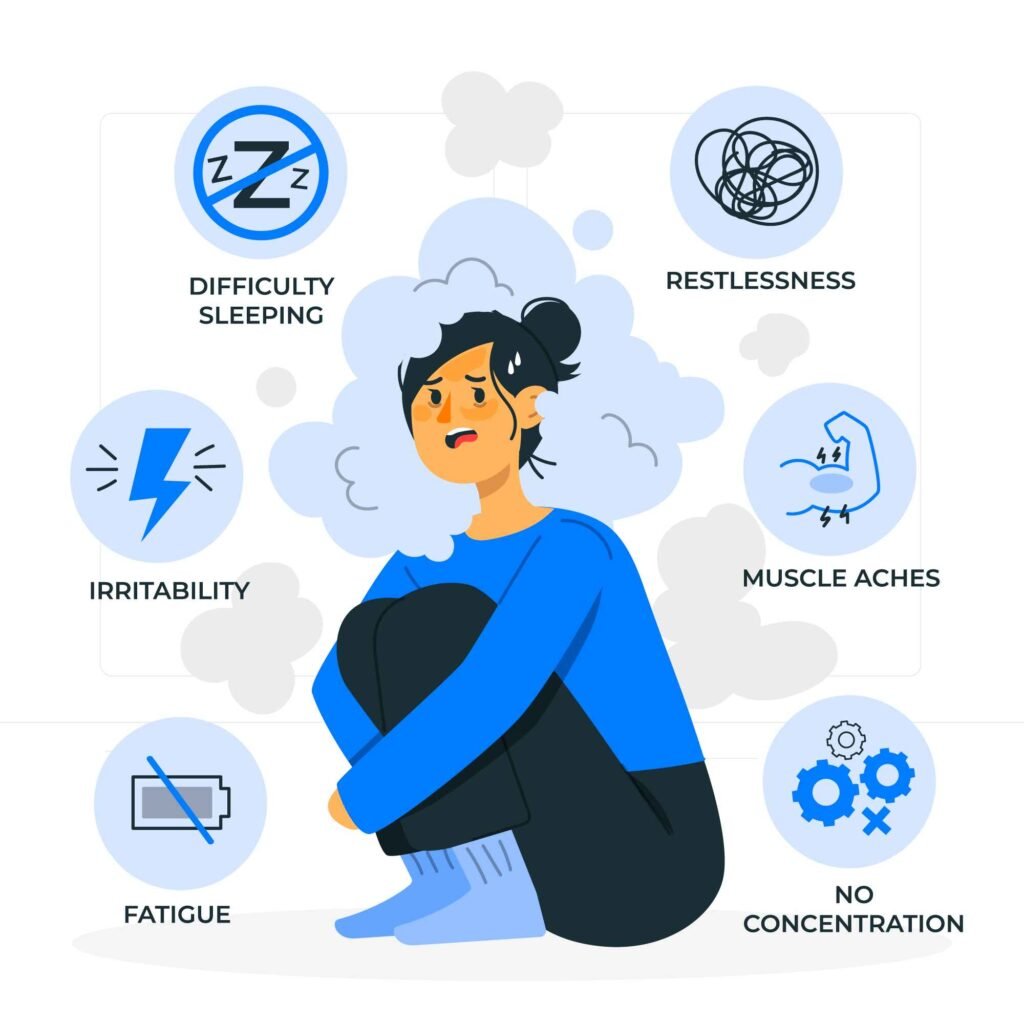
Workplace Mental Health
Introduction: The Growing Importance of Mental Health at Work
Workplace mental health is no longer a topic that can be brushed aside. With the rising awareness of mental well-being and its impact on productivity, organizations worldwide are taking active steps to create healthier, more supportive work environments. In this blog post, we will explore the key aspects of workplace mental health, actionable strategies for employers, and the benefits of fostering a mentally healthy workplace.
The Link Between Mental Health and Workplace Productivity
Mental health significantly influences employee performance, engagement, and overall job satisfaction. When employees experience stress, anxiety, or burnout, it directly affects their ability to concentrate, communicate, and contribute effectively.
Understanding the Costs of Ignoring Mental Health
- Reduced Productivity: Employees dealing with mental health issues often struggle with focus, leading to missed deadlines and errors.
- Increased Absenteeism: Mental health-related conditions, such as depression and anxiety, are among the leading causes of workplace absenteeism.
- High Turnover Rates: A toxic or unsupportive workplace can push employees to leave, increasing hiring and training costs.
The Ripple Effect on Teams
One employee’s mental health challenges can have a cascading effect on the entire team. Stress often spreads, lowering overall morale and collaboration. By addressing mental health proactively, employers can maintain a positive work culture.
Common Workplace Mental Health Challenges
Understanding the challenges employees face is the first step toward creating a supportive environment.
Stress and Burnout
- Unrealistic Expectations: Heavy workloads and tight deadlines contribute significantly to employee stress.
- Lack of Work-Life Balance: Constant connectivity through emails and messages often leads to overwork and exhaustion.
Anxiety and Depression
- Performance Pressure: High expectations without adequate support can increase anxiety.
- Isolation: Remote work, while beneficial in many ways, can lead to feelings of loneliness and depression.
Stigma Surrounding Mental Health
- Fear of Judgment: Employees often hesitate to share mental health struggles due to fear of being perceived as weak.
- Limited Resources: A lack of access to mental health resources further discourages employees from seeking help.
Creating a Supportive Workplace Environment
A proactive approach can help organizations create a healthier workplace for all employees.
Open Communication Channels
Encourage employees to speak openly about their mental health without fear of discrimination. Leaders can set the tone by normalizing mental health discussions.
Flexible Work Policies
- Remote Work Options: Offering flexible hours or hybrid work models can reduce stress and improve job satisfaction.
- Encouraging Breaks: Regular breaks during the day can help employees recharge mentally.
Training and Awareness Programs
Educate employees and managers about recognizing mental health signs and providing support. These programs can break stigma and foster understanding.
Implementing Mental Health Policies in the Workplace
One of the most effective ways organizations can demonstrate their commitment to mental health is through clear, comprehensive policies. These policies should address the key issues employees face and provide guidance on how to seek support when needed.
Creating a Mental Health Policy
A well-defined mental health policy should outline:
- Support for employees: How employees can access mental health resources, both internally and externally.
- Workplace accommodations: Providing flexibility or adjusting workloads for those experiencing mental health challenges.
- Confidentiality: Ensuring employees feel safe in sharing their mental health struggles without fear of judgment.
Mental Health Resources and Programs
Providing accessible mental health resources is essential. Many organizations offer Employee Assistance Programs (EAPs), which provide confidential support for personal and work-related issues. Additionally, offering mental health workshops or partnering with mental health organizations can empower employees to seek help early.
Practical Tips for Managing Stress and Anxiety at Work
Mental health in the workplace is not just about addressing severe conditions but also about implementing everyday strategies to reduce stress and anxiety. By creating a culture of well-being, companies can help employees manage their mental health effectively.
Encourage Healthy Work-Life Balance
In a fast-paced work environment, employees often struggle to balance their personal and professional lives. Encourage practices that promote well-being outside of work:
- Set Boundaries: Encourage employees to establish clear work hours and disconnect after work.
- Paid Time Off (PTO): Ensure employees are using their PTO, which allows for recovery and relaxation.
- Vacation Policies: Support employees in taking time off to recharge, preventing burnout.
Stress Management Techniques
Introduce employees to stress management practices that can improve their overall well-being:
- Mindfulness and Meditation: These techniques are proven to reduce stress and increase focus.
- Exercise Programs: Offer gym memberships or organize fitness activities to promote physical health, which is intrinsically linked to mental health.
- Ergonomic Workstations: Invest in proper seating and ergonomic setups to reduce physical strain, which can contribute to stress.
Supporting Employees Through Mental Health Challenges
It’s crucial for employers to support employees who are struggling with mental health challenges. A supportive workplace can help employees feel understood and valued, reducing the stigma associated with mental health issues.
Providing Emotional and Practical Support
Employees may need both emotional and practical support. A compassionate, understanding approach can go a long way in helping individuals cope with mental health challenges.
- One-on-One Conversations: Managers should foster open lines of communication, offering support and understanding when employees face difficulties.
- Workload Adjustments: Offering temporary changes to an employee’s workload can help ease the pressure they’re feeling.
- Return-to-Work Plans: For employees who are recovering from mental health issues, a gradual return-to-work plan can ease the transition.
Building a Culture of Empathy
An empathetic workplace is one where employees feel comfortable sharing their concerns and seeking help. Employers should foster an environment where mental health is not only acknowledged but actively supported. Key practices include:
- Leadership Training: Teach leaders how to spot signs of mental health challenges and how to approach affected employees with empathy and care.
- Team Building Activities: Foster team cohesion by organizing social events, collaborative tasks, or wellness days, all of which contribute to a positive work culture.
The Role of Managers in Promoting Mental Health
Managers play a pivotal role in promoting mental health in the workplace. Their leadership style can either support or hinder an employee’s mental well-being.
Lead by Example
Managers should lead by example by prioritizing their own mental health and well-being. This sets a precedent for employees to follow and removes the stigma surrounding self-care. Practices like taking breaks, prioritizing mental health days, and discussing mental well-being openly can show employees that their health matters.
Building Trust and Transparency
Managers who foster trust and transparency create an open atmosphere where employees feel more comfortable discussing their mental health. This can be achieved by:
- Regular Check-ins: Hold consistent one-on-one meetings with team members to discuss not only work-related matters but also personal well-being.
- Open-Door Policy: Ensure employees know they can approach managers with any concerns, including mental health.
The Benefits of Supporting Workplace Mental Health
Investing in workplace mental health initiatives not only improves the well-being of employees but also brings significant benefits to the organization.
Improved Productivity
Employees who feel supported are more likely to be engaged and productive. When workers know their mental health is taken seriously, they can focus on their tasks with greater clarity and energy, leading to higher output.
Reduced Absenteeism and Turnover
By addressing mental health issues early, employers can reduce absenteeism caused by stress, anxiety, and other mental health conditions. Employees are also more likely to remain loyal to an organization that values their well-being, reducing turnover and the associated recruitment costs.
Enhanced Company Reputation
Organizations that prioritize employee well-being are seen as attractive places to work. A good reputation in the market can attract top talent and enhance employee morale.
Strategies for Building Resilience in the Workplace
Building resilience in employees is a key strategy for ensuring long-term mental well-being. Resilience helps employees bounce back from setbacks, cope with stress, and stay motivated through challenges. A resilient workforce is more adaptable and capable of navigating workplace stressors effectively.
Resilience Training Programs
Organizations can implement resilience-building workshops and training programs designed to teach employees how to manage stress, adapt to change, and maintain their well-being during challenging times. These programs often focus on:
- Stress Management Techniques: Teaching employees how to manage stress effectively through breathing exercises, meditation, and time management.
- Cognitive Behavioral Skills: Helping employees reframe negative thinking patterns and adopt a more positive mindset.
- Mindfulness Practices: Encouraging employees to practice mindfulness and remain present in the moment, which can reduce anxiety and improve focus.
Encourage a Growth Mindset
Fostering a growth mindset is essential for building resilience. Encourage employees to view challenges as opportunities for growth rather than obstacles. This shift in perspective can reduce feelings of helplessness and improve their ability to persevere when faced with difficulties. Managers can reinforce this mindset by celebrating small successes and offering constructive feedback.
Mental Health Benefits of Workplace Diversity and Inclusion
A diverse and inclusive workplace can significantly contribute to mental health well-being. When employees feel valued and respected, regardless of their background, they are more likely to experience a sense of belonging and psychological safety.
Promoting an Inclusive Culture
An inclusive workplace embraces differences and creates a sense of belonging for everyone. Here’s how organizations can foster inclusion:
- Diversity Training: Conduct regular training sessions that promote understanding, empathy, and respect for cultural differences.
- Inclusive Policies: Develop policies that actively promote inclusion, such as anti-discrimination policies and support for employees from diverse backgrounds.
- Employee Resource Groups: Support the creation of employee resource groups that allow individuals to connect based on shared experiences or identities.
Reducing Workplace Discrimination
Discrimination, whether based on gender, race, or other factors, can contribute to workplace stress and mental health issues. It is essential for employers to actively combat discrimination by promoting equality in pay, career advancement, and access to resources.
The Role of Technology in Supporting Mental Health at Work
Technology has played a significant role in transforming workplace dynamics, and it can also be leveraged to improve mental health. From mental health apps to remote work tools, technology offers solutions that help employees manage their mental health while also enhancing overall work performance.
Mental Health Apps and Resources
There is a growing variety of apps and online platforms that support mental health in the workplace. Some offer stress management tools, while others provide access to therapy or counseling services. Popular apps include:
- Headspace and Calm: These apps offer guided meditation sessions to reduce stress and improve focus.
- BetterHelp: Provides online therapy sessions with licensed professionals, making therapy more accessible.
- Woebot: A chatbot that helps users manage their emotions and offers cognitive behavioral therapy (CBT) techniques for anxiety and depression.
Remote Work and Mental Health
Remote work has become more widespread, and while it offers flexibility, it also brings unique mental health challenges. Technology can help mitigate these challenges:
- Virtual Check-ins: Regular video calls and check-ins can help remote workers feel connected to their teams.
- Collaboration Tools: Platforms like Slack, Zoom, and Microsoft Teams allow employees to stay connected and collaborate effectively, reducing feelings of isolation.
How Leaders Can Create a Mentally Healthy Work Culture
Leaders set the tone for the workplace culture. When leaders prioritize mental health, it filters down to the entire organization. The actions and attitudes of leaders directly influence how employees perceive their mental health at work.
Model Mental Health Best Practices
Leaders should practice what they preach when it comes to mental health. By taking care of their own mental well-being, they encourage employees to do the same. This could include:
- Taking Mental Health Days: Leaders should take time off when needed and normalize taking breaks to prevent burnout.
- Promoting Work-Life Balance: By setting boundaries themselves and respecting others’ boundaries, leaders can encourage employees to do the same.
Encourage Peer Support Programs
Peer support programs can be extremely effective in promoting mental health in the workplace. These programs involve training employees to support each other by providing emotional and practical assistance. Peer support programs can include:
- Mentorship Initiatives: Pairing employees with mentors who provide guidance, support, and help with stress management.
- Buddy Systems: Creating buddy systems where employees are matched to check in on each other, offer emotional support, and foster camaraderie.
Mental Health Initiatives for Different Types of Work Environments
Not all work environments are the same, and the approach to mental health must be tailored to suit each specific setting. The strategies for improving mental health in an office setting may differ from those needed in high-pressure or remote environments.
Office-Based Environments
In traditional office settings, creating a comfortable and supportive environment is key. Initiatives can include:
- Relaxation Spaces: Designating quiet areas where employees can take short breaks to recharge.
- Social Events: Organizing team-building events and celebrations to strengthen relationships among employees.
High-Pressure Environments
Industries like healthcare, finance, and law often involve high stress and demanding workloads. To support mental health, employers should:
- Offer Decompression Activities: Activities such as yoga, massage therapy, or nature walks can help employees unwind.
- Peer Counseling: Provide a confidential space for employees to discuss stress and seek advice from trained peers.
Remote Work Environments
For remote workers, isolation can be a challenge. To support mental health, employers should:
- Promote Team Engagement: Regular video calls, virtual meetings, and team activities can help remote employees stay connected.
- Provide Mental Health Resources: Ensure remote employees have access to online therapy and stress management tools.



